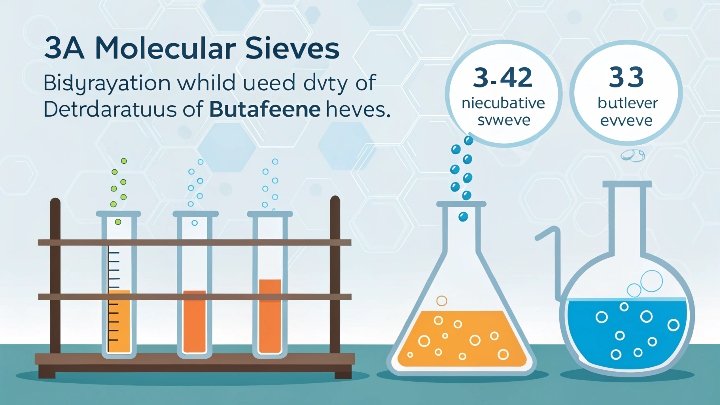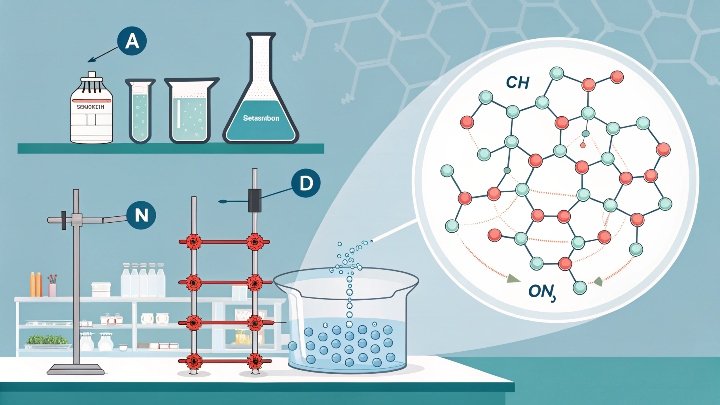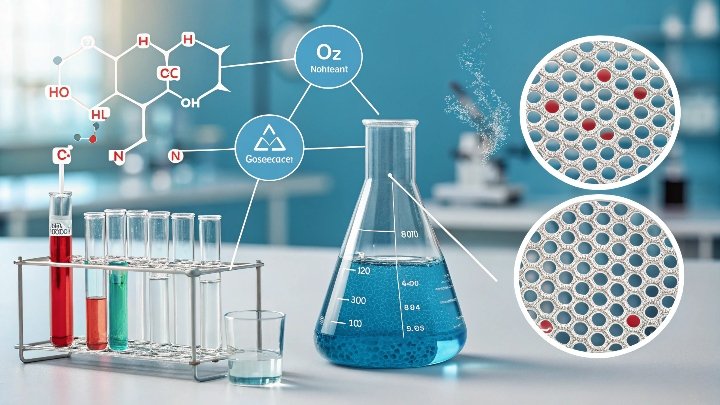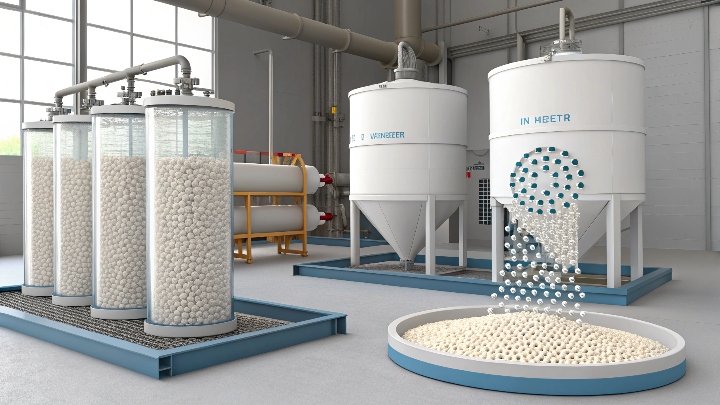Are you stuck with watery butadiene that slows your rubber-making reactions? I understand the frustration. I once faced the same issue, and I found a reliable fix.
The most effective molecular sieve for butadiene drying is 3Å. It physically adsorbs moisture while leaving butadiene intact. It boosts reaction speed and product quality without creating pollutants or altering the raw material.
I know how critical it is to maintain high-quality feedstocks in rubber production. Keep reading to learn the details of why 3Å molecular sieves are the best, how to use them, and where perfectly dry butadiene shines in real-world applications.
Why 3Å Molecular Sieves are the MVP for Butadiene Drying?
Is butadiene purity holding you back? I felt that pain when my polymerization reactions slowed down. Then I switched to 3Å molecular sieves, and it solved the issue.
3Å molecular sieves excel at capturing water from butadiene. They remove moisture without harming the butadiene structure. They also offer regeneration, high efficiency, and cost savings.
Why 3Å Molecular Sieves are the MVP
I realized the importance of 3Å molecular sieves when my early lab work showed me how water interrupts rubber synthesis. Water disrupts the polymerization rate and lowers final product quality. I tried different methods to dry butadiene, like distillation. But I found it hard to remove every trace of moisture. Any leftover water meant slower reactions and inconsistent yields.
That changed when I tested CNM 3A molecular sieves. They rely on physical adsorption. They target water molecules, which have a smaller diameter than butadiene molecules. Water’s kinetic diameter is about 2.8Å, so it fits perfectly into the 3Å pore size. Butadiene molecules are bigger. They do not get trapped, which preserves their composition. In practical terms, it means I can keep my feedstock free from water without introducing chemical additives. This approach keeps my raw materials pure.
I also appreciate the regeneration feature. When the sieve becomes saturated, I can heat it or lower the pressure to drive out adsorbed water. That means one batch of molecular sieves can last multiple cycles before replacement is necessary. That saves costs in the long run. It also fits well with the desire for an eco-friendly solution, because the process involves no harmful byproducts. I am mindful of budgets, so I like that 3Å molecular sieves strike a balance between cost-effectiveness and high adsorption performance. They work quickly, which helps maintain throughput in continuous processes. They also keep product consistency stable across multiple runs.
Below is a simple table that shows how 3Å molecular sieves outperform other options:
| Molecular Sieve Type | Pore Size | Ideal for Butadiene Drying? | Regeneration Cycle | Common Drawbacks |
|---|---|---|---|---|
| 3Å (e.g., CNM 3A) | ~3 Angstroms | Yes, best for moisture only | Efficient, repeated | None significant |
| 4Å | ~4 Angstroms | May adsorb some heavier molecules | Efficient, repeated | Might adsorb some hydrocarbons |
| 5Å | ~5 Angstroms | Often used for normal paraffins | Efficient, repeated | Possible butadiene co-adsorption |
| 13X | ~10 Angstroms | Designed for larger molecules | Efficient, repeated | Over-adsorption can occur |
I used to think bigger was always better. But 4Å or 5Å can sometimes adsorb more than just water. That leads to unintended co-adsorption of valuable hydrocarbons. 3Å hits the sweet spot because it targets water more precisely, letting the butadiene pass through unaltered. Over time, this consistent performance improved the yield in my polymerization steps. I noticed fewer byproducts and a more uniform final product. Once I saw the results, I knew 3Å molecular sieves, especially CNM 3A, had earned their “MVP” label.
Step-by-Step: How to Dry Butadiene Like a Lab Pro?
Struggling with complicated drying procedures? I was there when multiple steps ate up my time. Then I found a straightforward method that anyone can follow.
The best way to dry butadiene is to pass it through a 3Å molecular sieve bed. It is a simple setup that efficiently adsorbs water, even in continuous operations.
Step-by-Step Drying Process
When I first started drying butadiene, I remember feeling overwhelmed by the variety of approaches. Some recommended advanced distillation under vacuum. Others advised complicated chemical reactions. But I wanted a method that was safe, repeatable, and easy to manage. That is where 3Å molecular sieves came in.
Step 1: Prepare the Sieve Bed
I install the 3Å molecular sieve in a fixed bed. I typically fill a column with enough sieve material to handle the expected butadiene flow rate. I ensure the column design includes appropriate flow distributors, so the butadiene passes evenly. This step prevents channeling, which can lead to incomplete drying.
Step 2: Pre-Dry the System
I flush the system with a small amount of dry gas. This step removes any residual moisture in lines or valves. Sometimes I skip this step if I trust the system is already moisture-free, but I like to be sure.
Step 3: Flow Butadiene
Once the bed is set, I introduce the butadiene stream at the specified flow rate. The 3Å molecular sieves grab water from the butadiene. I monitor the outlet to check for any residual moisture. There are sensors and analyzers that measure water content in real time. If the reading is above my threshold, I may slow the flow rate or use a bigger column.
Step 4: Monitor Breakthrough
Eventually, the bed reaches saturation. Water starts to pass through the exit. I watch the moisture level. When it crosses the set limit, it is time to regenerate. Some people prefer to switch to a parallel bed if they want continuous flow. I sometimes do that in bigger operations.
Step 5: Regeneration
To regenerate, I apply heat or reduce the pressure, or do both. This step forces the water to leave the sieve. I vent this moisture safely. After regeneration, the sieve is ready to work again. This cycle can repeat many times, saving costs on adsorbent replacements.
I like this procedure for many reasons. It is easy to scale up or down. For a small lab scenario, I use a modest column. For larger industrial plants, I replicate the same principle but with bigger equipment and multiple columns in parallel. The consistent advantage is stable performance and minimal downtime. Plus, I do not need complicated chemical additives or large amounts of energy. The molecular sieve approach is straightforward. After I started using this method, I saw improved reaction speeds and better polymer quality. My final products had fewer impurities, and I had confidence that I was not introducing contaminants.
Sometimes new users worry about bed fouling or contamination. But if you keep an eye on feed composition and ensure no oils or heavy contaminants pass through, the 3Å sieve remains efficient. Routine checks and proper regeneration schedules help sustain good performance. This step-by-step approach can be integrated into existing setups with little hassle. I have done it, and it works.
The Perks of Perfectly Dry Butadiene: Applications and Benefits?
Want to unlock new possibilities with butadiene? I saw huge improvements in my rubber synthesis as soon as I used dried feedstock. Let me tell you why that matters.
Dry butadiene leads to stronger, more consistent end-products. It also accelerates polymerization and avoids side reactions. That means higher profits and better quality.
Perks of Dry Butadiene
When I started working with butadiene, my main goal was to produce high-quality rubber. I discovered that water content had a direct effect on polymerization speed. If there was water in the feed, it slowed down the reaction and even triggered unwanted side reactions. This not only reduced the final yield but also caused variations in the properties of the rubber. Customers want uniformity, so that inconsistency cost me business and peace of mind.
After I switched to using 3Å molecular sieves to dry my butadiene feed, I noticed an immediate improvement in polymer quality. The product had better tensile strength and elasticity. It was more consistent from batch to batch, so I reduced my waste and saved money. I also shortened the overall production time because my reaction rates improved. That gave me more throughput and made my operation more profitable.
Beyond the rubber field, I found that dry butadiene opens other possibilities. It can be used in various polymerization processes to create different products, from adhesives to specialty chemicals. Some of these products demand strict moisture control because water can break down catalysts or change the reaction path. Dry feed ensures that catalysts remain active for longer, reducing chemical usage and contamination. That approach helps me maintain a stable reaction environment. Meanwhile, I do not worry about corroding equipment, because water can cause rust or acid formation, especially if other components are present.
It also helps me comply with environmental and safety regulations. Eliminating water from the feed means fewer pollutants in the waste streams. There is less risk of forming byproducts that can be hazardous. In my experience, focusing on dryness has turned into a big plus for operational safety. I do not see unexpected temperature spikes or pressure swings caused by side reactions with water. That peace of mind is priceless in a busy production environment.
Here is a quick table of benefits I have observed:
| Benefit | Description | Result |
|---|---|---|
| Faster Reaction Speed | Less water to slow down polymerization | Increased throughput |
| Better Product Quality | Consistent polymer properties | Higher customer satisfaction |
| Lower Side Reactions | Stable catalyst performance | Fewer off-spec batches |
| Equipment Protection | Reduced corrosion and rust | Longer equipment lifespan |
| Environmental Friendliness | Fewer harmful byproducts | Safer and cleaner process |
I learned that many end uses, like latex production, require highly precise conditions. Moisture can cause lumps or partial coagulation, hurting product uniformity. Dry butadiene keeps everything even, so these specialized products maintain consistent quality. The broad applications range from automotive parts to shoe soles and even certain industrial chemicals used in adhesives. So, controlling moisture is not just about immediate yield. It is about ensuring a broad range of possible innovations in butadiene-based materials.
Conclusion
3Å molecular sieves changed how I dry butadiene. They remove water efficiently, boost reaction speed, and safeguard final product quality, all without unnecessary complexity.






